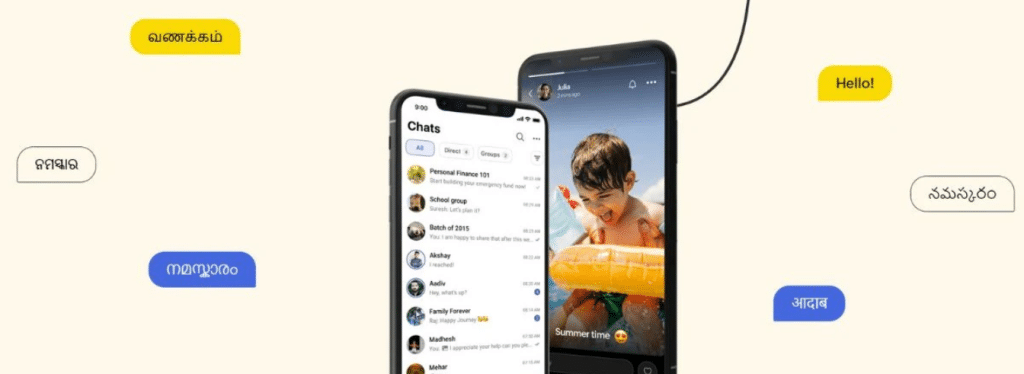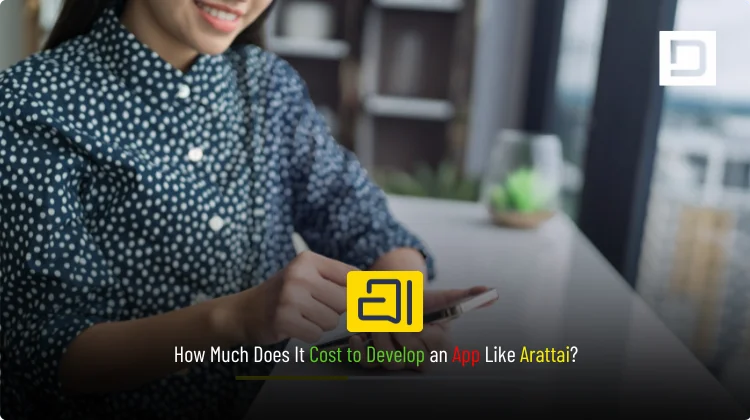How Much Does It Cost to Develop an App Like Arattai?
If you’re exploring the cost to develop an app like Arattai, you’re likely weighing user-grade privacy, lightning-fast chat, and scalable architecture against a realistic budget and timeline. In this in-depth guide, Depex Technologies breaks down the Arattai app development cost from every angle features, architecture, security, team composition, timeline, tech stack, and optimization strategies so you can plan with confidence. We also map your options to clear budget tiers between $75,000 and $250,000, aligned to what you’re actually shipping in v1, what you defer to v2, and what you design for scale from day one.
What Is Arattai and Why It Sets a High Bar
Arattai is known as a modern, privacy-aware messaging app: fast one-to-one and group chats, voice/video calling, media sharing, stickers, notifications that just work, and a clean, low-friction UX. Matching that user experience isn’t only about screens; it’s about a purpose-built backend, efficient protocols, robust security, and observability so you can diagnose issues in real time. When stakeholders ask “Why does a chat app cost this much?” the answer is simple: real-time communication at consumer scale looks simple, but under the hood it’s a distributed systems challenge.
Executive Summary: Budget Ranges by Scope
To ground expectations, here’s how typical budgets align to outcomes. All figures include design, development, QA, DevOps, and project management.
- MVP Core (Privacy-First Chats) – $75,000–$120,000
One-to-one chat, basic groups, text + images + files, push notifications, basic contact onboarding, admin console, analytics starter, and essential privacy controls. Optimized for a controlled beta or country-level pilot. - Standard “Arattai-Like” App – $120,000–$180,000
Adds large group messaging, message reactions, mentions, message status/read receipts, audio notes, profile management, invite/referral flows, robust media pipeline, rate limiting, content moderation hooks, and hardened monitoring. - Advanced, Scale-Ready Build – $180,000–$250,000
Adds end-to-end encryption with audited key management, voice/video calls (1:1 and small groups), ephemeral messages, backup/restore, in-app reporting and abuse workflows, multi-region readiness, and A/B testing infrastructure.
These are engineering-grade numbers aggressive but achievable designed around outcome-driven scope rather than vague “per-screen” counts.
Feature Set and Their Cost Drivers
A messaging product is a bundle of interdependent capabilities. Two builds can have the same “features,” yet one costs 30–40% more due to architecture choices, scale targets, compliance needs, and non-functional requirements. Below are the biggest cost drivers and what they imply.
1) Real-Time Messaging (1:1 and Groups)
- What it entails: Message send/receive flows, delivery and read receipts, presence, typing indicators, retries with weak networks, offline sync, conflict resolution.
- Cost impact: Higher than most founders expect. Building robust delivery semantics and sync logic typically consumes a major chunk of backend and mobile time.

2) Media Pipeline
- What it entails: Image/video compression, thumbnails, adaptive streaming for video, virus scanning for files, storage lifecycle rules, and CDN wiring.
- Cost impact: Moderate to high. It increases cloud cost (storage + egress) and adds edge-case QA cycles (slow networks, low-end devices, corrupted files).
3) Groups and Community Features
- What it entails: Large group sizes, admin roles, moderation tools, mentions, reply threads, pinned messages, and searchable history.
- Cost impact: Moderate. The logic and data modeling for permissions and history retrieval require careful design to keep queries fast and cheap.
4) Voice and Video Calling
- What it entails: WebRTC signaling, TURN/STUN, bandwidth adaptation, echo cancellation, background handling, and graceful recovery on poor networks.
- Cost impact: High. Even with mature frameworks, tuning for device variability and carrier constraints needs significant engineering and QA time.
5) Security and Privacy
- What it entails: Transport security, end-to-end encryption, secure key management, anti-spam/abuse, rate limiting, secure storage, protected logs, and data retention policies.
- Cost impact: Moderate to high, depending on encryption scope (server-side vs. end-to-end), threat model, and audit requirements.
6) Observability and Admin Tooling
- What it entails: Centralized logging, tracing, dashboards, alerts, feature flags, admin console for user/content oversight, and incident runbooks.
- Cost impact: Moderate. It reduces operational risk and accelerates iteration, but it must be built intentionally.
7) Growth and Onboarding
- What it entails: Contact discovery, invite flows, referral rewards, deep links, and soft nudges to activate cold users.
- Cost impact: Low to moderate, but incredibly valuable for ROI. Poor onboarding kills retention; good onboarding pays for itself.
The Architecture: Where Reliability and Cost Meet
An “Arattai-class” app calls for a resilient, extensible architecture:
- Clients: Native Android (Kotlin) and iOS (Swift) for best performance and OS-level integrations. React Native or Flutter can work for speed-to-market, with careful optimization for background services and notifications.
- Real-Time Layer: MQTT or WebSockets for persistent connections. Broker choice and connection strategy heavily influence battery usage and perceived responsiveness.
- Message Service: Idempotent message processing, distributed queues for retries, write-optimized storage (e.g., DynamoDB/Cassandra) plus search indexes for retrieval.
- Media Service: Upload pre-signing, virus scan hooks, compression/transcoding workers, and CDN for global delivery.
- User/Group Service: Profiles, settings, membership graphs, permissions.
- Notifications: FCM/APNs wiring, topic management, and quiet-hour logic.
- Security: TLS everywhere, token rotation, device binding, abuse detection, and optional end-to-end encryption with audited key handling.
- Ops: IaC (Terraform), container orchestration (Kubernetes), blue/green or canary deploys, and autoscaling policies.
Why this matters for cost: architecture determines your development velocity, cloud bill, and incident rate. Over-engineering is expensive; under-engineering is more expensive later. Depex designs around a lean but sturdy backbone that grows with adoption.
Cost Breakdown by Phase
While each build is unique, a typical “Arattai-like” roadmap follows four phases. The hours below are indicative for one platform (Android or iOS). For dual-platform parity, multiply the app-specific effort by ~1.8–2.0 if going fully native. Cross-platform may reduce net mobile hours but add integration tuning.
1st Phase : Product Definition & Architecture (2–4 weeks)
- Activities: Requirements, UX flows, clickable prototypes, schema design, threat model, trade-offs (native vs. cross-platform), environment plan.
- Typical share of budget: ~10–12%.
- Why it matters: Decisions here eliminate rework later. Teams that rush discovery pay for it during QA and production.
2nd Phase: Core Build (8–14 weeks)
- Activities: Messaging engine, groups, media, onboarding, notifications, admin basics, and observability setup.
- Typical share of budget: ~55–65%.
- Gotchas: Sync conflicts, message ordering under unstable connectivity, media edge cases, device background policies.
3rd Phase : Security Hardening & Scale Hooks (3–6 weeks)
- Activities: Rate limiting, abuse prevention, encryption scope, audit logging, backup/restore pathways, and cost-aware caching.
- Typical share of budget: ~15–20%.
- Result: A system that stays stable as you add users and features.
4th Phase : QA, Beta & Launch (3–5 weeks)
- Activities: Regression, device matrix testing, network throttling tests, beta cohort feedback, store submissions, and production runbooks.
- Typical share of budget: ~10–15%.
- Outcome: You launch with confidence and a plan for the first 90 days.

Sample Scope-to-Budget Mapping (Inside $75,000–$250,000)
1) MVP Core — $75,000–$120,000
- Android or iOS app, essential real-time chat (1:1 + small groups), text + image/file sharing, push notifications, profile, onboarding, analytics starter, admin console v1, and basic moderation.
- Lightweight encryption (transport + secure storage), rate limiting, and minimal content scanning.
- Suitable for pilots, early adopters, and regional or community launches.
2) Standard “Arattai-Like” — $120,000–$180,000
- Android + iOS, larger groups, reactions, mentions, read receipts, audio notes, improved media pipeline, reporting flow, scalable push strategy, and observability dashboards.
- Optional experiment flags for UX variants; tighter abuse prevention and retention analytics.
3) Advanced & Scale-Ready — $180,000–$250,000
- Android + iOS parity, voice/video calling, ephemeral messages, end-to-end encryption with audited key flows, multi-region readiness, A/B testing, expanded admin and moderation panels, and cost-optimized storage tiers.
- Designed for aggressive growth, PR launch, or compliance-sensitive environments.
Regional Rates and Team Composition
Budgets change with team mix and geography. Depex uses blended pods to control costs without sacrificing expertise:
- Core roles: Product Manager, UX/UI Designer, Mobile Engineers (Android/iOS or cross-platform), Backend Engineers, DevOps, QA Automation, Security/Privacy Advisor, and Project Lead.
- Resourcing model: For MVPs, a compact pod (6–8 contributors) with overlapping responsibilities keeps velocity high and communication tight. For advanced builds, specialized roles (media pipeline, WebRTC, cryptography) join for focused sprints.
This pod model is why a feature-equivalent build might cost less with Depex: you pay for senior specialists only when you need them.
Hidden Costs Founders Often Miss
Even well-scoped projects can drift. Here are common budget traps and how we handle them:
- Unbounded media expectations: “All file types, any size.” We right-size upload limits and compression profiles early, cutting cloud bills and crashes.
- Notification storms: Over-eager alerts cause churn. We add quiet hours, digest patterns, and relevance ranking so users stay engaged without feeling spammed.
- Bot and spam defense: Abuse will come. We combine device heuristics, velocity checks, and server-side reputation to protect your community and your infra costs.
- Overlong beta with scope creep: We set decision gates for v1 vs. v2, keeping launch dates—and budgets predictable.
- Ambiguous privacy postures: We document data flows and enable opt-ins/opt-outs that align with your brand and local regulations.
Security & Privacy: Building Trust Into the Product
Trust is your growth engine. Users will not stay if they feel exposed. Our approach includes:
- Secure by default: TLS, token rotation, encrypted at rest, secrets vaulting, and least-privilege IAM.
- End-to-end encryption options: From scoped rollouts (1:1) to broader coverage, with key transparency strategies.
- Audit-ready logging: Redacted logs, retention windows, and incident audit trails.
- Abuse pathways: In-app report flows, automated triage, and admin follow-ups that respect both privacy and safety.
Doing this well typically adds 10–20% to build effort, but it protects brand equity and unlocks partnerships.
Tech Stack Choices That Influence Cost
There’s no single “correct” stack, but there are smart defaults:
- Mobile: Kotlin (Android) and Swift (iOS) for performance; Flutter or React Native for faster cross-platform delivery if your team accepts some platform-specific bridging.
- Realtime: WebSockets or MQTT; choose based on connection stability requirements and operational familiarity.
- Backend: Node.js, Go, or Java/Kotlin for services; event queues (Kafka, RabbitMQ); cache (Redis); and a write-optimized store (Cassandra/DynamoDB) with indexed search (Elasticsearch/OpenSearch) for queries.
- Media: S3-class object storage, CDN for global delivery, serverless transcoding workers.
- Infra: Kubernetes + Terraform, autoscaling, feature flags, and blue/green or canary deployment strategies.
- Observability: Centralized logs, metrics, tracing, synthetic tests, and on-call runbooks.
The practical question is: what can your team support at 2 a.m.? Depex’s job is to pick stable building blocks your post-launch team can run confidently.
Timeline Expectations
A realistic timeline reduces burn and builds trust:
- MVP Core: 12–18 weeks to TestFlight/Play Beta for one platform, then 3–6 weeks for the second platform or cross-platform stabilization.
- Standard Build: 18–26 weeks for both platforms, including hardened backend and Observatory v1.
- Advanced Build: 24–32+ weeks, depending on calling, encryption scope, and multi-region needs.
We prefer milestone-based billing with demoable increments every 2–3 weeks so stakeholders see tangible progress.
AI-First Search & GEO/AEO Considerations
Since you asked for an AI-First Search friendly article, let’s address how your messaging app can surface well in AI answers and generative search:
- Structured content surfaces: Use well-named, human-readable settings and help articles so AI engines can extract clear answers (“How do I turn on disappearing messages?”).
- Clear privacy stance: Publicly documented data handling and encryption posture help AI answer engines recommend your app with confidence.
- Feature terminology consistency: Avoid jargon drift. Consistent naming improves Generative Engine Optimization (GEO) and Answer Engine Optimization (AEO).
- FAQs with canonical responses: Short, scannable, and up-to-date responses reduce hallucination in AI answers and increase your inclusion in “best privacy chat apps” summaries.
- Performance signals: Lightweight pages, fast media, and error-free deep links all send positive quality signals to AI ranking systems.
Depex bakes GEO/AEO into your product and marketing foundation, not as an afterthought.
How to Reduce the Arattai App Development Cost Without Sacrificing Quality
You can stay within $75,000–$150,000 without short-changing user value if you plan smartly:
- Start with one platform: Launch Android first if your market justifies it, validate retention, then add iOS with learnings baked in.
- Sequence calling features: Ship messaging first; add voice/video after you prove daily active usage.
- Define media boundaries: Cap file sizes; optimize compression; move heavy transcoding to later milestones.
- Defer complex encryption scopes: Begin with strong transport/storage security; phase end-to-end encryption where it maximizes trust and adoption.
- Use feature flags and staged rollouts: Push smaller changes fast, observe, then scale. It saves rework and protects ratings.
- Adopt a blended team model: Pair senior leads with mid-level builders; bring niche experts in for short, targeted bursts.
Each tactic trims cost without kneecapping usability.
Monetization Paths That Influence Scope (and Budget)
Your revenue model shapes your roadmap, and therefore your cost:
- Freemium + Premium: Locks, larger group limits, VIP badges, or advanced privacy controls in paid tiers.
- Enterprise/Community Licensing: Private communities with custom moderation and analytics; requires admin dashboards and SLA reporting.
- Add-on Services: Cloud backup, device sync, premium stickers, and storage upgrades.
- Ads (cautious): If planned, set clear privacy boundaries and auditing for trust.
Designing for revenue early clarifies v1 scope and avoids expensive pivots.
Post-Launch Costs You Should Budget For
Launching is the beginning:
- Cloud and CDN: Varies with usage; a lean pilot often starts under four figures monthly, then scales with traffic.
- Monitoring & On-Call: Alerts, incident response, and periodic chaos drills.
- Continuous Security: Patch cadence, dependency management, and periodic pentests.
- Roadmap Velocity: Set aside 20–30% of initial build cost for the first six months of enhancements and optimization.
Depex typically offers success sprints post-launch: small, high-impact releases to lift retention and ratings.
Why Teams Choose Depex for “Arattai-Like” Apps
- AI-First Product Thinking: We build experiences that AI search engines can understand and recommend.
- Performance on Low-End Devices: India-first, emerging-market ready—optimized networking, storage, and battery.
- Security as a Feature: Practical, auditable privacy flows that strengthen your brand.
- Pod Model with Senior Oversight: You get speed without chaos, and quality without bloat.
- Outcome-Bound Billing: Milestones tied to working software, not just hours.
A Practical Way to Decide Your Budget Tier
Ask three questions:
- What must be true to earn a five-star rating in your launch market? If calling is a must, target the $180k–$250k tier.
- What’s the minimum lovable product we can ship in 16–20 weeks? If messaging excellence trumps bells and whistles, the $75k–$120k tier fits.
- How confident are we about growth channels? If you need experiments, analytics, and flags from day one, plan for the $120k–$180k tier.
If your answers land between tiers, Depex will right-size a scope that respects both ambition and runway.
Conclusion: Build a Fast, Private, Arattai-Caliber Messenger With Depex
Delivering a trustworthy messaging app is not just a feature checklist. It’s the interplay of real-time systems, privacy, media efficiency, and operational clarity. Within a budget window of $75,000 to $250,000, you can launch anything from a crisp MVP to a scale-ready platform with voice/video and advanced encryption. The key is sequencing the right capabilities at the right time—and engineering them to be observable, secure, and cost-aware.

Ready to move from estimate to execution?
Depex Technologies designs and ships “Arattai-like” messaging products that delight users and respect your budget. We’ll help you choose the right stack, plan the rollout, and deliver a version you’re proud to put your name on.
Contact Depex Technologies today to scope your build, align timelines, and launch with confidence.






